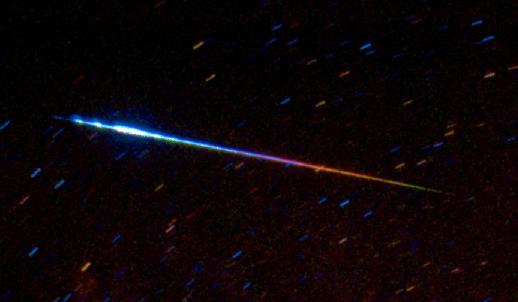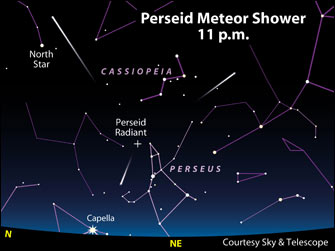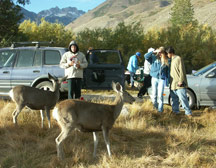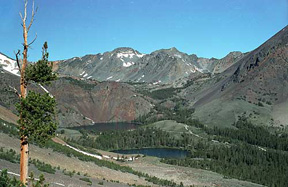Astro 28V: Field Astronomy in Hot
Springs Country for the Perseid Meteor Shower
Aug 10-12, 2007
Post-Trip
Highlights and Photos
 This
Astro 28 installment will be very special; we're going to highlight the most
spectacular of the annual meteor showers - the
Perseids. Caused by the gradual melting and dissintegration of
Comet Swift-Tuttle, this is a reliable shower, producing 60-100 meteors per
hour for a comfortable observer snug in his/her
This
Astro 28 installment will be very special; we're going to highlight the most
spectacular of the annual meteor showers - the
Perseids. Caused by the gradual melting and dissintegration of
Comet Swift-Tuttle, this is a reliable shower, producing 60-100 meteors per
hour for a comfortable observer snug in his/her  sleeping
bag with eyes aimed skyward and hands on a thermos of hot chocolate. We'll array
ourselves in a little circle and watch the sky, oooo'ing and ahhhh'ing and photographing
the bits of rock and pebbles that burn up 40 miles above our heads, speeding
~150,000 feet per second into our atmosphere.
sleeping
bag with eyes aimed skyward and hands on a thermos of hot chocolate. We'll array
ourselves in a little circle and watch the sky, oooo'ing and ahhhh'ing and photographing
the bits of rock and pebbles that burn up 40 miles above our heads, speeding
~150,000 feet per second into our atmosphere.
The Perseids are active all through
early August, but meteor rates will rise each night until maximum on August
12. There are also two other meteor showers active in the early morning hours
- the Capricornids
and the Delta
Aquariids, so we'll have fun disentangling which meteors belong
to which shower. We'll observe on both nights. And, before the radiant rises
we will also have out the telescopes to study the star formation regions dotting
the summer Milky Way in Sagittarius, Scorpius, and Aquila, including the Lagoon,
Trifid, and Eagle Nebulae made famous by the Hubble Space Telescope images.
Our Campground:
 Honeymoon Flat Campground near Bridgeport, 25 miles north of
Mono Lake.
with it's beautiful tufa formations.
The picture at left was taken from this campground last fall. This is centrally
located in hot springs country, with Buckeye
Hot Springs, Travertine
Hot Springs, and Fales Hot Creek all just a few miles away. It's
also the site of last year's
Astro 28S class. It's on the Walker River after it emerges from
the glaciated canyon that is home to Twin Lakes. This pretty spot has some advantages:
First, it's a regular campground and therefore has water. It's also close to
Twin Lakes which may be a swim option late on Saturday. It's also got a good
horizon especially towards the south, and this is important for summer viewing
as the most spectacular telescopic sights of the summer sky are clustered near
the Scorpius/Sagittarius region which is home to the center of our Milky Way
Galaxy, and this rides low in the south for northern hemisphere observers. Finally,
it's much closer to the hot springs which are most interesting to study geologically
and refreshing to experience directly. Temperatures should be warm, 80F in the
afternoon and 40F at dawn. This campground is first come / first serve, and
its possible we might not get campsites. In that case, we'd look for a spot
close to Buckeye Hot Springs, or we can consider Virginia Lakes canyon, not
far from Mono Lake.
Honeymoon Flat Campground near Bridgeport, 25 miles north of
Mono Lake.
with it's beautiful tufa formations.
The picture at left was taken from this campground last fall. This is centrally
located in hot springs country, with Buckeye
Hot Springs, Travertine
Hot Springs, and Fales Hot Creek all just a few miles away. It's
also the site of last year's
Astro 28S class. It's on the Walker River after it emerges from
the glaciated canyon that is home to Twin Lakes. This pretty spot has some advantages:
First, it's a regular campground and therefore has water. It's also close to
Twin Lakes which may be a swim option late on Saturday. It's also got a good
horizon especially towards the south, and this is important for summer viewing
as the most spectacular telescopic sights of the summer sky are clustered near
the Scorpius/Sagittarius region which is home to the center of our Milky Way
Galaxy, and this rides low in the south for northern hemisphere observers. Finally,
it's much closer to the hot springs which are most interesting to study geologically
and refreshing to experience directly. Temperatures should be warm, 80F in the
afternoon and 40F at dawn. This campground is first come / first serve, and
its possible we might not get campsites. In that case, we'd look for a spot
close to Buckeye Hot Springs, or we can consider Virginia Lakes canyon, not
far from Mono Lake.
 As
a backup in case the regular campgrounds are all full (not likely), we'll head
for the camping area along Virginia
creek in an open meadow near Virginia Lakes,
As
a backup in case the regular campgrounds are all full (not likely), we'll head
for the camping area along Virginia
creek in an open meadow near Virginia Lakes, high above the spectacularly scenic aspen groves of Conway Summit above Mono
Lake and just below the Sierra Crest at the boundary of Yosemite National Park.
During the day we'll explore Mono Lake (gulls and other birds love this lake
for breeding and as a way station during migrations). One advantage of the Virginia
Lakes site is that it is higher in elevation and therefore probably cooler (however,
during the day we'll be exploring
high above the spectacularly scenic aspen groves of Conway Summit above Mono
Lake and just below the Sierra Crest at the boundary of Yosemite National Park.
During the day we'll explore Mono Lake (gulls and other birds love this lake
for breeding and as a way station during migrations). One advantage of the Virginia
Lakes site is that it is higher in elevation and therefore probably cooler (however,
during the day we'll be exploring
Virginia Lakes (left) are in a picturesque
high canyon, and Mono Lake (right) is far below. Our camping area would be just
off the lower right side of this photo (click for enlarged version). The canyon
sides are steep though, and our view of the sky would not be as good as at Honeymoon
Flats. Below Virginia Lakes is Conway Summit, and its beautiful stands of quaking
aspen, still green in August, but just beginning to change to yellow in a few
higher elevation spots.

(Conway aspen photo: copyright Doug Broussard. All Rights Reserved)
The Plan
During the day, we'll study the local
geology and lecture on the history of the earth and the inner solar system,
with special emphasis on the geologic history of the Sierra / Basin & Range
boundary region in which we'll be camping. I'll be treating you to my famous
French crepes breakfast on our first morning, and cooked eggs and/or veges on
the second morning. I'll also be providing dinners of pasta and other delicacies.
Maps, academic handouts, and carpooling will be handled on our pre-trip meeting
in August just before the weekend trip. Click below for the details. Here is
the planetary science hand-out
which I'll be distributing once I see you at camp.
Grading
Your grade will be based on two components.
(1) A take-home written final exam. You'll have 10 days to complete and mail
in or drop off. and (2) your demonstrated curiosity, participation, and helpfulness
during the get-togethers during the field trip. Fun is an essential ingredient
to any good learning experience.
Schedule
Camper's Checklist
Back to Rick's HomePage
 This
Astro 28 installment will be very special; we're going to highlight the most
spectacular of the annual meteor showers - the
Perseids. Caused by the gradual melting and dissintegration of
Comet Swift-Tuttle, this is a reliable shower, producing 60-100 meteors per
hour for a comfortable observer snug in his/her
This
Astro 28 installment will be very special; we're going to highlight the most
spectacular of the annual meteor showers - the
Perseids. Caused by the gradual melting and dissintegration of
Comet Swift-Tuttle, this is a reliable shower, producing 60-100 meteors per
hour for a comfortable observer snug in his/her  sleeping
bag with eyes aimed skyward and hands on a thermos of hot chocolate. We'll array
ourselves in a little circle and watch the sky, oooo'ing and ahhhh'ing and photographing
the bits of rock and pebbles that burn up 40 miles above our heads, speeding
~150,000 feet per second into our atmosphere.
sleeping
bag with eyes aimed skyward and hands on a thermos of hot chocolate. We'll array
ourselves in a little circle and watch the sky, oooo'ing and ahhhh'ing and photographing
the bits of rock and pebbles that burn up 40 miles above our heads, speeding
~150,000 feet per second into our atmosphere. 

 high above the spectacularly scenic aspen groves of Conway Summit above Mono
Lake and just below the Sierra Crest at the boundary of Yosemite National Park.
During the day we'll explore Mono Lake (gulls and other birds love this lake
for breeding and as a way station during migrations). One advantage of the Virginia
Lakes site is that it is higher in elevation and therefore probably cooler (however,
during the day we'll be exploring
high above the spectacularly scenic aspen groves of Conway Summit above Mono
Lake and just below the Sierra Crest at the boundary of Yosemite National Park.
During the day we'll explore Mono Lake (gulls and other birds love this lake
for breeding and as a way station during migrations). One advantage of the Virginia
Lakes site is that it is higher in elevation and therefore probably cooler (however,
during the day we'll be exploring 